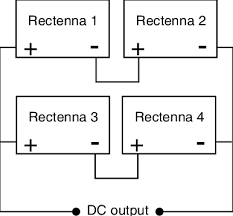_ Nano antennas (Rectenna)
Introduction of system nano antennas ( Rectenna solar system)
Researcher and author: Dr. Afshin Rashid
Note: Since nano antennas have the ability to absorb a wide angle, even in the case of oblique solar radiation to the surface of the solar panel, their efficiency is up to a significant limit is maintained. This system can also use the energy radiated from the earth or the terrestrial radiation that is caused by the sun's daily radiation to the earth's surface and has a wavelength of <10 micrometers. /span> , i.e. absorb frequencies around 90 terahertz.
That's why the reason of the solar rectenna system nano antennas by collecting these radiations duringat night or in bad weather conditions. can produce electrical energy. Currently, the diode and antenna structures used in the solar rectenna using They are made by electronic sketching method. Although this construction method is expensive and time-consuming to produce on a laboratory and research scale, but if these structures are produced in a large volume and with a method suitable for production, they reduce the cost and speed of the construction process
It should be mentioned that Rectenna has been studied in recent years, especially in the issue of power transmission in microwave band. For example, in the theoretical mode for a single frequency of 9.2 GHz, more than 10% of the expected efficiency is 3. Of course, the practical efficiency of making these devices may be slightly different and should be determined in practice. Dipole antenna with =6> Linear polarization and length λ/2, which has a relative bandwidth of 11%, will be able to collect about pW 75.2. For this reason, if i=8 >Using an antenna with double polarization, pW 5.5 power will be obtained. Considering the low receiving power of each independent antenna, it is customary to use anti-arrays in this cell, which also has its own rules and methods. a> Since the use of optical nanoantennas to collect solar energy provides a practical solution with high efficiency compared to other common photovoltaic technologies such as solar panels, has led to rapid development in the nano industry and optical materials.has.
Conclusion :
Since nano antennas have the ability to absorb a wide angle, even in in the case of oblique solar radiation to the surface of the solar panel, their efficiency is up to A significant limit is maintained. This system can also use the energy radiated from the earth or the terrestrial radiation that is caused by the sun's daily radiation to the earth's surface and has a wavelength of <10 micrometers. /span> , i.e. absorb frequencies around 90 terahertz.
Researcher and author: Dr. Afshin Rashid
Specialized doctorate in nano-microelectronics






